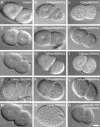Caenorhabditis elegans nucleoporins Nup93 and Nup205 determine the limit of nuclear pore complex size exclusion in vivo
- PMID: 12937276
- PMCID: PMC284812
- DOI: 10.1091/mbc.e03-04-0237
Caenorhabditis elegans nucleoporins Nup93 and Nup205 determine the limit of nuclear pore complex size exclusion in vivo
Abstract
Nuclear pore complexes (NPCs) span the nuclear envelope and mediate communication between the nucleus and the cytoplasm. To obtain insight into the structure and function of NPCs of multicellular organisms, we have initiated an extensive analysis of Caenorhabditis elegans nucleoporins. Of 20 assigned C. elegans nucleoporin genes, 17 were found to be essential for embryonic development either alone or in combination. In several cases, depletion of nucleoporins by RNAi caused severe defects in nuclear appearance. More specifically, the C. elegans homologs of vertebrate Nup93 and Nup205 were each found to be required for normal NPC distribution in the nuclear envelope in vivo. Depletion of Nup93 or Nup205 caused a failure in nuclear exclusion of nonnuclear macromolecules of approximately 70 kDa without preventing active nuclear protein import or the assembly of the nuclear envelope. The defects in NPC exclusion were accompanied by abnormal chromatin condensation and early embryonic arrest. Thus, the contribution to NPC structure of Nup93 and Nup205 is essential for establishment of normal NPC function and for cell viability.
Figures





Similar articles
-
Early embryonic requirement for nucleoporin Nup35/NPP-19 in nuclear assembly.Dev Biol. 2009 Mar 15;327(2):399-409. doi: 10.1016/j.ydbio.2008.12.024. Epub 2008 Dec 30. Dev Biol. 2009. PMID: 19146848
-
The conserved transmembrane nucleoporin NDC1 is required for nuclear pore complex assembly in vertebrate cells.Mol Cell. 2006 Apr 7;22(1):93-103. doi: 10.1016/j.molcel.2006.02.015. Mol Cell. 2006. PMID: 16600873
-
Vertebrate Nup53 interacts with the nuclear lamina and is required for the assembly of a Nup93-containing complex.Mol Biol Cell. 2005 May;16(5):2382-94. doi: 10.1091/mbc.e04-10-0857. Epub 2005 Feb 9. Mol Biol Cell. 2005. PMID: 15703211 Free PMC article.
-
Nuclear pore complex composition: a new regulator of tissue-specific and developmental functions.Nat Rev Mol Cell Biol. 2012 Nov;13(11):687-99. doi: 10.1038/nrm3461. Nat Rev Mol Cell Biol. 2012. PMID: 23090414 Review.
-
What can Caenorhabditis elegans tell us about the nuclear envelope?FEBS Lett. 2007 Jun 19;581(15):2794-801. doi: 10.1016/j.febslet.2007.03.052. Epub 2007 Mar 30. FEBS Lett. 2007. PMID: 17418822 Review.
Cited by
-
A Nucleoporin Docks Protein Phosphatase 1 to Direct Meiotic Chromosome Segregation and Nuclear Assembly.Dev Cell. 2016 Sep 12;38(5):463-77. doi: 10.1016/j.devcel.2016.08.006. Dev Cell. 2016. PMID: 27623381 Free PMC article.
-
N-glycosylation is required for secretion and mitosis in C. elegans.PLoS One. 2013 May 14;8(5):e63687. doi: 10.1371/journal.pone.0063687. Print 2013. PLoS One. 2013. PMID: 23691084 Free PMC article.
-
The Arabidopsis SUPPRESSOR OF AUXIN RESISTANCE proteins are nucleoporins with an important role in hormone signaling and development.Plant Cell. 2006 Jul;18(7):1590-603. doi: 10.1105/tpc.106.041566. Epub 2006 Jun 2. Plant Cell. 2006. PMID: 16751346 Free PMC article.
-
Nup155 regulates nuclear envelope and nuclear pore complex formation in nematodes and vertebrates.EMBO J. 2005 Oct 19;24(20):3519-31. doi: 10.1038/sj.emboj.7600825. Epub 2005 Sep 29. EMBO J. 2005. PMID: 16193066 Free PMC article.
-
Structural and functional analysis of Nup133 domains reveals modular building blocks of the nuclear pore complex.J Cell Biol. 2004 Nov 22;167(4):591-7. doi: 10.1083/jcb.200408109. J Cell Biol. 2004. PMID: 15557116 Free PMC article.
References
Publication types
MeSH terms
Substances
LinkOut - more resources
Full Text Sources
Other Literature Sources
Molecular Biology Databases

